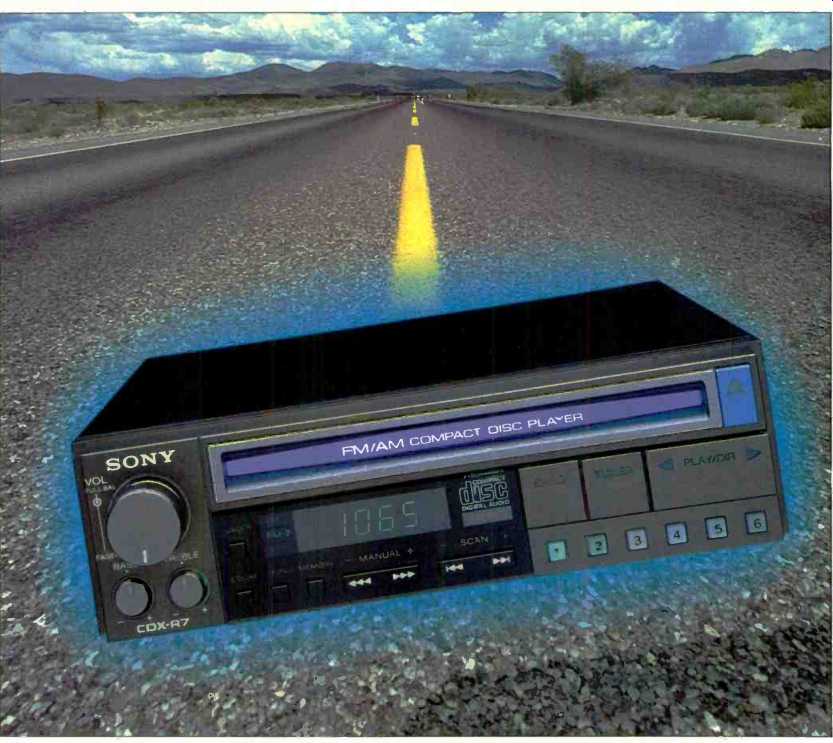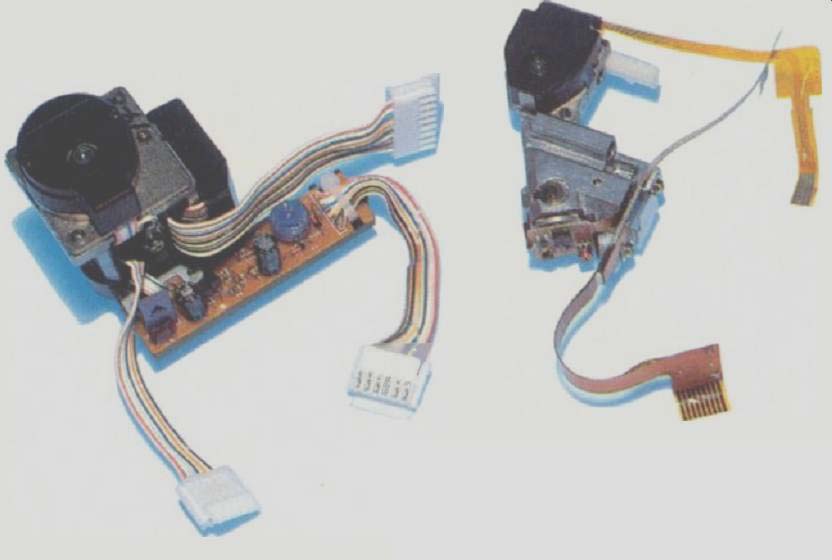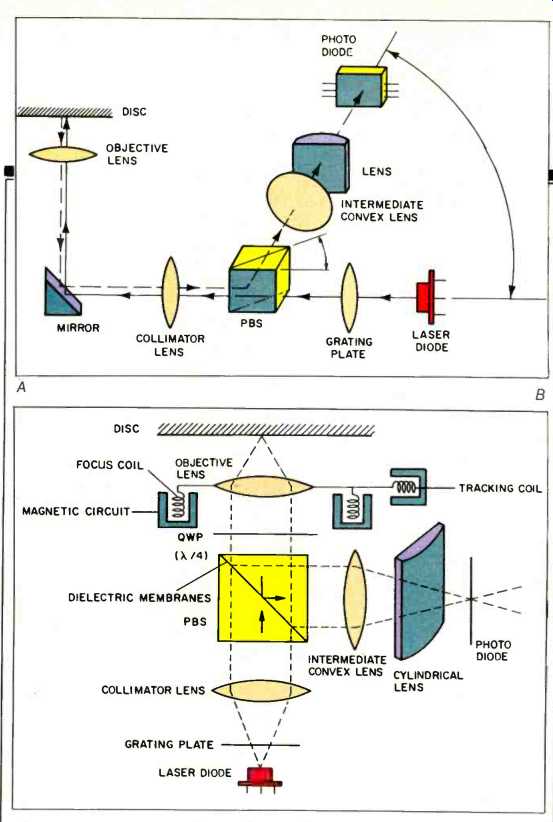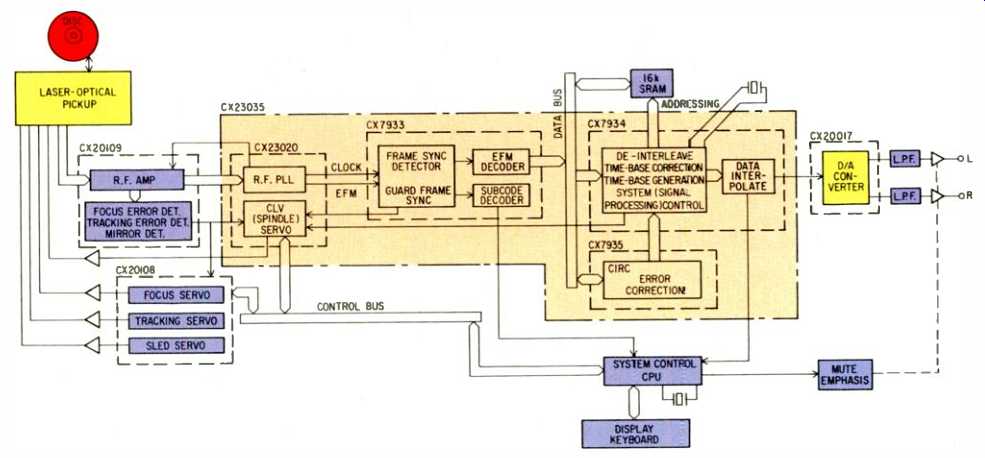
by LEONARD FELDMAN
It's been more than 18 months since I first laid eyes (and hands, and ears) upon the first CD player that I could operate in my own home and lab. Since then, I must have tested at least two dozen or more players, and I've collected over 100 Compact Discs to play on them. All the while, I've been hearing tales from various manufacturers about the ease with which CD players could be designed for use in moving vehicles. I had no doubts in my own mind about the coming of car CD players. After all, more than a year ago, when several members of the audio press toured the facilities of Philips and Polygram Records in Holland and West Germany, our hosts transported us from one factory to another aboard a mini-bus. And there, perched atop the dashboard of that vehicle, was a standard home CD player, sitting on a cushion of sponge-like plastic. The only thing that had been done to it, I was told, was to convert its power sup ply to work at 12 V instead of at the standard European 220 V. As I recall, the CD player actually functioned quite well-so long as we traveled at constant speeds along Holland's generally fine superhighways. Riding along city cobblestone-paved roads, however, I heard several instances of mistracking and momentary muting. We were assured that it was of time before such problems, as well as possible problems of temperature extremes and miniaturization, would be solved.

above: Sony's first-generation laser-optical pickup (left) dwarfs the new, compact one used in the CDX-R7 car CD player
Sony, the co-developer of the CD system now universally accepted and endorsed by the audio industry and the hundreds of thousands of music lovers who already own home players, believes that the time for a car CD player has come. Since Sony had given me a sneak preview of their first CD player a year and a half ago (Audio, November 1982), I felt it only appropriate that I be given a peek at their first CD player designed for use in moving vehicles, the CDX-R7. Sony was happy to oblige, and here are the details of what I learned and saw:
According to Sony, the two primary designs that were needed to make a car CD player practical were in the areas of the laser-optical pickup (including its driver servos) and in large scale integrated (LSI) circuitry. Since Sony has its own, in-house IC design, and production division, they were able to come up with a new, one-chip digital LSI for all primary functions of the proposed car CD player. As for the need for a smaller, yet stable and reliable laser-optical system, Sony also developed a miniaturized laser optic mechanism which, they tell me, will be applicable not only to car CD players but-and I should have guessed this to "Walkman"-type CD products in the near future! Having developed two new major components, Sony was then able to design a car CD player/ tuner/preamp component which actually meets European DIN dimensional mounting standards. In other words, it will fit in-dash. This means we can fore see the day when CD player/receivers will be offered as factory-built options by car manufacturers, as well as for after-purchase installation in or under the dash.
Front Panel Features
The front panel of the Sony CDX-R7 CD player is no larger than that of any in-dash car stereo front panel. Along its top is a slot into which the Compact Disc is inserted. When you insert a disc partway, the mechanism takes over and draws it into the machine, placing it in position for play. Push the eject button at the far right, and the disc comes out partway, but if you fail to remove it the rest of the way within 15 S, the disc retracts and the system is held in the pause mode-a neat arrangement that protects the disc from dust. If you then fail to release the pause within 15 minutes, the player's power is turned off completely.
The left end of the front panel houses the usual controls you would expect to find on any car stereo front end component: Concentric volume, fader and balance controls and bass and treble tone controls. A switch beneath the left end of the disc slot deter mines what indications will be visible in the nearby display area. When playing CDs, touching this switch alters the display from showing time of day (clock function) to showing the track number of the disc being played. Unlike many home CD players, however, this unit does not tell you time played within a given track. When using the built-in AM/FM tuner, the same switch makes the display alternate between showing time of day and frequency of tuned-to stations.
A local/distance switch and an FM mono/stereo switch along the lower edge of the panel are used only when listening to the tuner. Remaining controls and switches located beneath the display area, however, serve different purposes, depending upon whether you are listening to a disc or to the tuner. The button labeled "Memory," used to memorize preset station frequencies when in the tuner mode, controls the laser pickup's return to the beginning of a disc for replay of the first track when listening to CDs. The fast forward/rewind switch, used to scan quickly through the music on a disc (at 10 times normal speed, and at an amplitude which is reduced by about 12 dB), serves as a manual tuning rocker switch in the tuner mode. A second rocker switch allows you to advance to the next (or previous) track of a CD (just as in Sony's home CD players) but becomes a scanning control in the tuner mode. It pauses for 4 S as each station is locked in, allowing you to stay on that station or continue scanning. The "Play/Dir" button at the far right of the small front panel performs the same play/pause function as on home CD players. Remaining controls relate exclusively to the tuner operation and include an AM/FM band-selector switch, a tuner on/off switch, and six numbered preset buttons. Because there are secondary buttons labeled "FM1," "FM2," and "AM" that work in conjunction with the presets, it is possible for a total of 18 favorite stations (12 FM and 6 AM) to be memorized.
Performance Specifications
Although I have not had a chance to measure the performance of this first car CD player/tuner/preamp in my own lab (I will as soon as I can get my hands on a production unit), published specs for the CD section come close to those found in home units. Harmonic distortion is quoted at 0.007%, while frequency response is rated as flat within 1 dB from 12 Hz to 20 kHz.
Dynamic range and signal-to-noise ratio are the usual 90 dB or better, and stereo separation exceeds 80 dB be tween channels. Line output level is 0.775 V for 0-dB (maximum) recording level, and the entire unit weighs only about 3 1/2 pounds!

Fig. 1--New laser-optical pickup (A) has a folded light path (note mirror)
to make it far more compact than Sony's original home-player pickup (B).
FM tuner usable sensitivity is quoted as 15 dBf, and strong-signal signal-to noise ratios are 70 and 68 dB for mono and stereo respectively. Capture ratio, especially important in a vehicular FM tuner, is only 1.5 dB. Harmonic distortion at 1 kHz is 0.1% for mono and 0.15% for stereo signals; separation at mid-frequencies is 40 dB. Alternate channel selectivity is rated at 70 dB.
The New Laser-Optical System
As mentioned earlier, the design of this small CD player was made possible by the development of a new, miniature laser-optical pickup mechanism and a new, single-chip LSI. A simplified diagram of the optical pickup is shown in Fig. 1A. Its operation is some what similar to earlier, physically larger optical systems used in CD players. An emitted laser beam produced by the laser diode (LD), at the right in the diagram, passes through a grating plate and a collimator lens, after which it is deflected 90° by a 45° mirror and focused by another lens to the reflecting surface of the CD. Between the grating plate and the first lens is a Polarization Beam Splitter (PBS) which incorporates dielectric membranes acting as a sort of prism, directing the laser beam from the diode onward to the 45° mirror, and the reflected beam from the surface of the disc to the photo diode (PD). The cylindrical lens between the PBS and the photo diode focuses the reflected beam of light.
The chief difference between this optical pickup and larger ones used in earlier CD players (Fig. 1B) is the fact that this pickup has, in a sense, been folded back on itself to conserve space. This miniaturization has been accomplished without sacrificing any of the elements needed for accurate and stable servo tracking and focusing of the laser beam onto the precise "track" of the CD and at the precise depth required for accurate reading of the digital information embedded be low its surface.
The One-Chip LSI
The silicon gate C-MOS LSI developed for digital signal processing of Compact Disc signals combines the functions previously performed by as many as four separate ICs. The functions of this new IC, the CX23035, are shown in Fig. 2, with the functions of the four ICs it replaces indicated.

Some nine separate functions are performed by the one chip. They include bit-clock generation using a phase-lock loop circuit, data decoding, detection protection and insertion of frame-synchronizing signals, detection and correction of serious data errors, interpolation by "mean value" or previous-value holding, decoding and error correction of sub-code signals, constant linear velocity (CLV) servo/ spindle motor control, track counter with eight bits, and Central Processing Unit (CPU) interface via a serial bus.
The IC itself is configured as an 80-pin flat package, and its maximum power dissipation is 500 mW. It may be safely stored at any temperature from-67° to + 302° F (- 55° to + 150° C) and may be operated at any temperature from - 4° to + 167° F (- 20° to + 75° C). The ability to operate over such a wide temperature range is, of course, essential for any device intended for use in the hostile and extreme environment of an automobile.

Fig. 2--New ICs in Sony car player include CX20109 and CX20108 at left,
and CX23035 LSI chip (which replaces four earlier ICs whose functions are
indicated by dotted-line boxes within the beige-colored area).
Of the several additional chips shown in Fig. 2, two were specifically designed for this car CD player and are of particular interest. The first of these, CX20108, is silicon monolithic bipolar IC developed as a servo signal processor for the CD player. Its functions include focus control (search, servo on/off, gain control), tracking control (servo on/off, single track jump, multi-track jump and gain control), and sledding or scanning control (servo on/ off, fast-forward scan and fast-reverse scan). This IC is housed in a 30-pin flat package.
The other IC of particular interest, CX20109, is a silicon monolithic bipolar IC as well. This IC has an r.f. amplifier for handling the three-spot optical pickup output from the laser pickup and signal processing circuits that take care of the following functions required in the CD player: Focus-error amplification, tracking-error amplification, auto asymmetry-control amplification, focus "OK" comparator circuitry, mirror comparator circuitry, and EFM (modulation or data) comparator circuitry. This IC is configured as a 24-pin flat mini-package.
What Next for CD Technology?
There are many who feel strongly that the total impact of the Compact Disc on the typical consumer will not be realized until the complete CD product family reaches the market place. A Compact Disc player for cars is just one of those products. Other possible products envisioned by Sony and others include a practical CD ROM (Read Only Memory disc for data processing and computer applications), CD-Still-Frame graphics (early forms of which have already been demonstrated by Sony and other high tech companies), CD-DRAW (Direct Read After Write, or recordable CDs), and CD-CADA (Cable Digital Audio).
These new digital media concepts and others are being worked on in laboratories all over the world and are sure to lead to exciting and useful products in the not too distant future. Meanwhile, the next exciting development is certainly going to be the car CD player.
Will it eventually replace the cassette deck in cars as the cassette deck re placed the 8-track cartridge? Will a dedicated digital tape recording system (which may be standardized within the coming year) end up as a worthy competitor to the CD player in cars? How will digitally encoded graphics on CDs change the way we listen to music and watch our video monitors? All of this geometrically expanding digital technology is almost too much to con template-and to keep up with. But as always, I will keep trying to tell you about it as it happens.
=============
(Audio magazine, Jul. 1984)
Also see:
Sony's Digital Compact Disc Player -- Exclusive First Look! (Nov. 1982)
Sony CDP-101 Digital Audio Disc Player--Postscript (Jan. 1983)